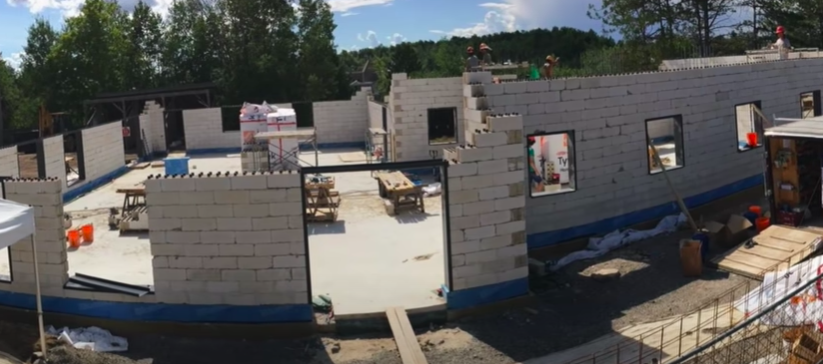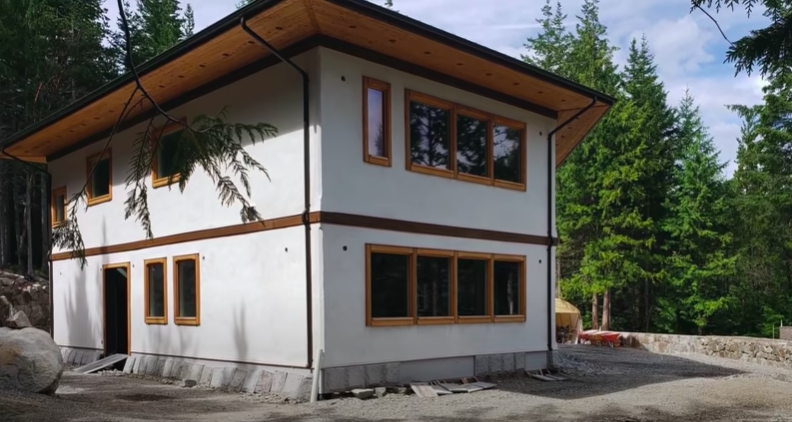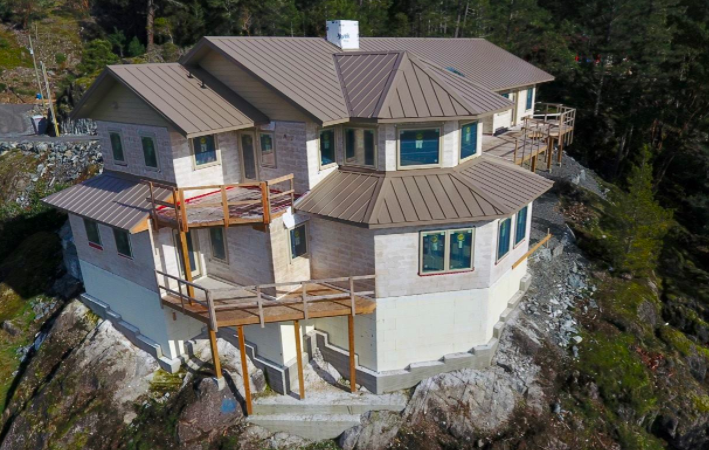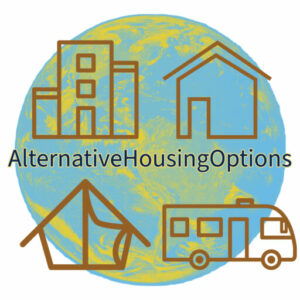Building any home or structure can negatively affect the environment, especially when you consider the lumber it takes for wood beams or the process of creating steel beams for support. These traditional construction items require heavy equipment to transport and aid in the construction process. Now, don’t get me wrong, I’m not against using, reusing, and replenishing the resources available on the planet. But when you investigate the process of home construction, there is are some negative consequences to building…unless you are using sustainable, carbon-negative materials. What?? Is that even possible? Yes, my green-loving friend, it is.
Hempcrete is made of the hemp plant inner woody core or hull mixed with a lime-based binder. The hemp hull or “Shiv” has a high silica content which allows it to bind well with lime. The high silica content is unique to hemp fiber. The hemp hull and lime binder create a lightweight cement-like material that weighs a seventh the weight of concrete blocks. The pre-made blocks have a framing system inside that is load-bearing and more robust, and more durable than traditional concrete. Many companies have created hemp blocks to eliminate the need for a framing system. Hempcrete can be used as a great insulation and can be rammed into wall-frame molds to build a house.

What are hempcrete or hemp blocks used for?
Hempcrete is used in home and office construction. On its own, hempcrete is a non-load-bearing product glued together with a lime binder between runs of bricks. These sustainable bricks absorb and release internal moisture vapor, preventing condensation and dampness from taking hold, making them a great option to eliminate mold in buildings.
What kind of framing is used with hempcrete or hemp blocks?
Some companies use wood or steel beams as the framing inside the hemp blocks during the construction process. Here is a great example by HempBlock International of how that technology is used to build a hemp house.
Another company, JustBioFiber, has created an ingenious system of sustainable framing and pre-made hemp blocks to create an interlocking hemp block system. They have a great video explaining hemp blocks and how they can be used to build a house. I personally find this fascinating. My children love to build with interlocking blocks, and this system really tempts me to buy some land and build a hemp blockhouse. You can watch the video here.
Hempcrete and hemp blocks can be used for their insulation properties alone. R-value measures insulation. The R-value of material “measures its resistance to heat flow through a wall.” This means that insulation with a higher R-value is better at preventing heat loss in the winter and preventing heat gain in the summer. Hempcrete has a similar R-value to other fibrous insulations, like cotton or straw. The R-value is between 2 and 4 per inch. To compare, concrete has an R-value of 0.1 to 0.2 per inch, making it a poor insulator.
Hempcrete can be added to wall cavities to improve the insulative qualities. The hemp blocks can also be cut down to fill any areas with dead space.
What is a hempcrete home?

A hempcrete home is a house with walls, insulation, and in some cases, flooring made entirely of hempcrete. Hempcrete can be dried into blocks which are then used much like bricks. They are interlocking with wood or steel beams and limestone masonry between the runs. Another layer of limestone binder is applied like stucco to complete the exterior.
Here is an interesting video about building a home with hempcrete.
What are the cons of hempcrete?
The low rate of compressive strength of hempcrete is its biggest drawback. At a maximum, hempcrete compressive strength is 3.5 megapascals (MPa). In contrast, the lowest compressive strength of concrete is around 17 MPa. Construction firms can’t use hempcrete in heavy load-bearing work unless you use a hemp block with an internal framing system.
What are the benefits of hempcrete?
- Low- or zero-carbon footprint
- Nontoxic materials and high indoor air quality
- Excellent moisture-handling properties
- Durable
- High thermal insulation
- 50% – 70% energy savings
- Fire-proof
- Termite-resistant
- Breathable walls
- Design flexibility
- CO2 sequestration
- High acoustic performance
- Zero landfill
- Natural Substrates for Plasters and Renders
Currently, hempcrete is a material choice for owners and builders who wish to create a building with the following qualities:
Sustainability of Hemp
Hemp is a beneficial crop requiring no pesticide, weed killer, fungicide, or fertilizer. Weeds can’t grow in a hemp crop because it grows so thickly. Any crop following the hemp will not need weedkiller either, as the hemp killed the roots. This allows farmers to grow hemp in rotation with other crops like rye or barley. The seed oil can be harvested for food supplements, and the fiber can be used for cloth. The hull can even be used for animal bedding.
Building a home with hempcrete

As a DIY home building project, current prices show that hempcrete costs about $12.54 per square foot for the product alone. Hemp Tech Global lists its prices on its official website. We’ll use a 2,500 square foot house with a 9-foot ceiling as an estimated size. According to Hemp Tech Global, you’ll need 300 bags of hemp hulls and 300 bags of lime binder for our example house. Those materials would cost $18,200.
Labor and construction can cost up to $236/square foot if you consider the process Hemp Tech Global has documented. They say, “it could take between 10 and 13 days to mix and install the hempcrete.” The company then recommends completing its two-day training course to become Hempcrete Certified. If you don’t have this certification, the company charges $4,800 to send one of its team to help with installation.
A hempcrete house based on Hemp Tech Global’s process would cost over $300,000 for a 1600 square foot house. Not cheap on the initial build, but with the rising housing market could become more cost-effective in the future.
One of the most considerable cost savings with a hemp house compared to a traditional stick-built house is the savings over time from lower heating and cooling costs. A hemp house could save you as much as $14,000-$25,000 in energy bills over 50 years.
Frequently asked questions about hempcrete and hemp blocks
Is hempcrete better than concrete?
Hempcrete does better insulating, removing carbon from the air, and preventing mold and moisture build-up than concrete. However, it is not stronger than concrete on its own. Without a framing system, hempcrete does not have the compression strength that concrete possesses.
Can hempcrete be used for foundations?
Hempcrete cannot be used for the foundation of a house. Hemp absorbs moisture over time and will biodegrade if exposed. However, JustBioFiber has created a pre-formed block using soy, similar to the hemp block, to be used below grade.
Is it cheaper to build with hempcrete?
Unfortunately, with the current construction costs and processes, building with hempcrete or hemp block costs a little more than a traditional build. Whatever the standard price is for build per square foot, add a minimum of $60. So, where it may cost an average of $120 per square foot on a traditional build, a hempcrete structure may cost $180 per square foot or more.
Can hempcrete cause you to get high?
The hemp used to create hempcrete and hemp blocks are not the same as the THC intoxicant producing marijuana. Hemp homes definitely cannot get you high. Hemp contains less than 0.3% THC.
Hempcrete and hemp block houses are a way of sustainable building in the future. Building with hemp has many advantages. It is suitable for your health by reducing carbon and moisture in your air; it’s durable, fire and termite resistant, and versatile as it can be used inside any structural framing to create a rounded look or as blocks for a typical monolithic style. It also has some limitations, and the cost is the most obvious. It is also not DIY friendly as it does require specialized knowledge required to build a house using hemp. Even with the disadvantages, I find it fascinating that you could grow and build with a sustainable product in two months.
Check out our other articles about alternative housing options.


